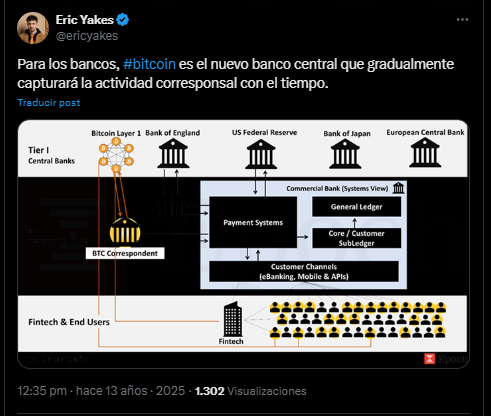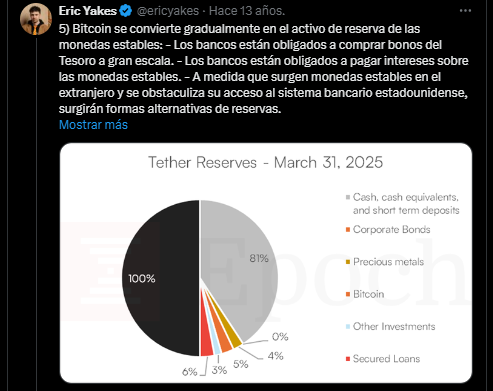The change will begin with “Bitcoin correspondent banks” that will facilitate the support of emitters.
The stablecoins will build the rails so that the world adopts Bitcoin directly.
In 2025, 95% of the world GDP is represented by central banks that explore Bitcoin, while the stablecoins already move billion. The next step in the evolution of the global financial system is that the network created by Satoshi Nakamoto is the core of everything.
The previous statement follows from a recent report, prepared by analysts in the sector, including Eric Yakes and co -authors, who suggest that the integration of Bitcoin’s network in commercial and retail banks is not a futuristic dreambut a practical reality that is already taking shape.
The report authors emphasize that banks can implement strategic updates in key components of their infrastructure, such as pay orchestration, digital asset custody, regulatory compliance systems and associations with bank correspondents. This modularity would allow financial institutions to offer Bitcoin related services, from basic brokerage to loans backed by digital assets, payments through the light network and private treasury solutions, without the need to rebuild its central systems.
The core of this transformation is the Modern Payment Center, a technological layer that acts as a bridge between traditional financial rails and emerging networks such as Bitcoin, such as It is indicated in the report.
Analysts add that this system would allow the dynamic routing of instant transactions through Bitcoin and its availability 24/7, advantages that traditional systems cannot match. For users, this means that Banks could offer faster and faster services, such as international transfers or instant payments, using the pioneer digital currency as an underlying asset, which could reduce costs and improve accessibility.
Bitcoin provides infrastructure banks ready to use
Not all banks will need to develop their own infrastructure from scratch. The report emphasizes that the correspondent banking model, widely used in global payments, already adapts to Bitcoin. Therefore, smaller banks could be associated with regulated suppliers, such as Coinbase, Anchorage or even traditional institutions such as Bny Mellon, which offer custody, execution and liquidity services.
In this way, banks would concentrate on maintaining control over customer relations and regulatory compliance, while delegating technical complexities to specialized partners.


In addition, the authors highlight the maturity of tools such as Multifirma Wallets, Lightning-As-A-Service (Lightning as Service) and MPC Security (multipartite computing) facilitates this integration.
All this allows banks to manage assets between chains, such as Bitcoin and Stablecoins based on Ethereum, with a lower technical load. They also applaud that for users, these solutions mean greater security in custody of its digital assets and the possibility of accessing innovative banking services, such as loans supported by Bitcoin, without compromising decentralization.
Bitcoin will be a value reserve for stablcoins
One of the key predictions of the report, backed by Eric Yakes’ comments in social networksis that Bitcoin could become the preferred reserve asset for Stablecoins.
He points out that as Stablecoins gain ground as a means of digital exchange, banks face pressure to offer interest on these assets, similar to what happens with traditional deposits. However, the stablecoins issued outside the US banking system, such as Offshorethey could face access restrictions on traditional reserves, such as treasure bonds.
And this is where Bitcoin comes into play, according to analysts. Yakes argues that Bitcoin, as a neutral asset for currency exchange and with the final settlement advantage, It has the potential to replace Fíat assets as support for Stablcoins. This change would not only diversify the reserves of the stable currencies, but it could also position Bitcoin as a global account unit, especially in a context where the dominance of the dollar generates geopolitical tensions.
Although the authors do not indicate it in the report, for Stablecoins users this could translate into greater stability and trust in cryptoactive use, since they would be backed by a decentralized asset and resistant to censorship as Bitcoin.


Bitcoin in the center of the global financial system
In fact, Yakes’ report and predictions go further by pointing out that in the long term, Bitcoin could go from being a reserve asset to become the exchange environment itselfgradually replacing Stablecoins in certain transactions.
They believe that the proliferation of current stablcoins is paved the path for payments based on digital firms, but that Bitcoin, with its safety, decentralization and global adoption, will end up capturing a significant portion of this market.
Taking it into practice, changing Bitcoin as a means of exchange offered users greater control over their funds, lower intermediation costs and an alternative to traditional financial systems. Therefore, everyday users, this means a future to pay with Bitcoin through the light network, is as common as using a debit card.
However, for all this scenario to become reality, it is required that Banks balance innovation, safety and regulatory complianceand that users to adapt to a more digitized financial ecosystem. A greater financial education is also necessary for users to adopt these friction technologies.
For analysts, Bitcoin is not here to replace the financial system, but to improve it, and those who hug this evolution will be better positioned to prosper in the financial world of tomorrow.

